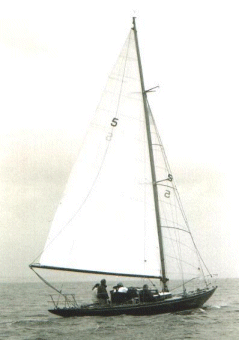
|
||||||||||||||||||
ArticlesDublin Bay One-Design Class Few designers are so
laconic as Mr Mylne who sends us the plans for his Dublin Bay
One-Design Class with the sole descriptive remark: "The design is
obviously intended to be that of a fast cruiser with accommodation for
living on board in moderate comfort." We shall therefore have to
omit the usual 'Designers Remarks', but it would have been interesting
to have known the terms of reference given to Mr. Mylne and the way in
which he complied with them. There is plenty to be said about the design, for it is seldom that we have the pleasures of seeing the lines of a new vessel from the board of so great an artist as Alfred Mylne. Five boats have been built to this design, and were completed only shortly before the war, and they now await the end of the war to be used. These new 24-footers should prove to be worthy successors to the famous old 25-foot class which was started in 1898 and has been going strong ever since. It will be remembered, too, that some years ago Mylne also designed a 21ft. one-design class for Dublin Bay.
Since the objects
which inspired this design - a fast cruiser with accommodation for two
people- are very similar to those for which the Yachting World 25ft.
L.W.L. designing competition was devised, comparison with the
published designs should prove most interesting to readers. The necessity for
providing accommodation has of course influenced the lines and
dimensions. The hull is comparatively beamy with long overhangs which
are beautifully formed and contribute much to the handsome appearance.
The midship section is especially pleasing, showing ample stability
and fairly light displacement for the beam, while the fore and aft
lines indicate an easily driven vessel with a high maximum speed. It
is interesting to note that the formation of the load waterline is in
marked contrast to the practice adopted to present-day designs. The
fairly long straight bottom or the keel will ensure easy slipping. A large cockpit 5ft.
6in. long will give room for the crew when racing without placing
their weight too far aft. At the forward end of the cockpit a hatch
covers a 2-cylinder Watermota engine which drives the propeller offset
to starboard. Down below, the
general arrangement of the accommodation can be seen by studying the
plan. For sleeping two pipe berths are placed over the settees while a
third person could be accommodated in the forecastle. The W.C. is shut
off from the passageway by two doors, the larger one if the two swings
across to shut off both passage and closet from the saloon. The raised
coach roof extends just far enough forward to provide headroom in the
W.C. compartment. It is not to be
expected that the space available in a boat of this size and type and
type with her rather low freeboard, would allow for full headroom and
a wide cabin sole, but there is almost 6 feet under the extend of the
companion hatch by the galley where it is most important. Under the
beams of the coach roof there is 5ft. 3in., while the sitting headroom
is adequate. Between the settees the foot space is 1ft. 9in. The sail area of 519
square feet by Y.R.A. measurement is considerable for a boat of this
size, especially as the actual total area with the genoa is about 600
square feet. The old 25ft. class carried a great deal more sail than
this with their topsails set and, what is more, they could continue it
carry it in a fresh breeze. Modern rig does not require is great an
area, but the hard driving Dublin Bay owners should be able to
maintain their reputation with these new boats. The designer has
attained the sail area without using a very high mast, for with a foot
of 19ft., the mainsail has a moderate hoist of 39 feet. There are two
pairs of crosstrees, the jib stay being taken to the upper pair, the
upper shrouds being secured about 2 feet below the truck. The sail
plan has obviously not been influenced by the Y.R.A rating rule,
because a spinnaker boom of 12ft. 6in. long has been provided, whereas
the foot of the fore triangle is only 11 feet. There is always great
interest in yachts of about this size and type, and these Dublin Bay
One-Design craft are eminently suitable for fast cruisers where the
emphasis is upon ailing qualities rather than below decks. |
||||||||||||||||||
Dublin Bay 24 designed by Europa Web Design | Contact |
||||||||||||||||||
